Business Diploma: ISO 14001, WEEE, RoHS, Reliability & Market Research
VerifiedAdded on 2021/05/31
|10
|2967
|94
Report
AI Summary
This business diploma report provides a comprehensive overview of several key business concepts. It begins by exploring the relevance of ISO 14001, WEEE, and RoHS directives, emphasizing their importance in controlling hazardous substances in electronic goods and the impact of environmental regulations on electronic manufacturing. The report further discusses the concept of reliability in product design and manufacturing, examining its effects on product pricing and customer perceptions, along with the application of the 'bathtub' curve. Finally, it highlights the significance of market research in developing new products, increasing sales, and understanding competitor information, detailing various market research methods and their relevance to an organization, the impact of pricing on sales and profits, and the application of the five P’s in marketing. This document is available on Desklib, a platform offering a wide array of study tools and solved assignments for students.

Running head: BUSINESS DIPLOMA 1
Business Diploma
Student’s Name
Institutional Affiliation
Business Diploma
Student’s Name
Institutional Affiliation
Paraphrase This Document
Need a fresh take? Get an instant paraphrase of this document with our AI Paraphraser
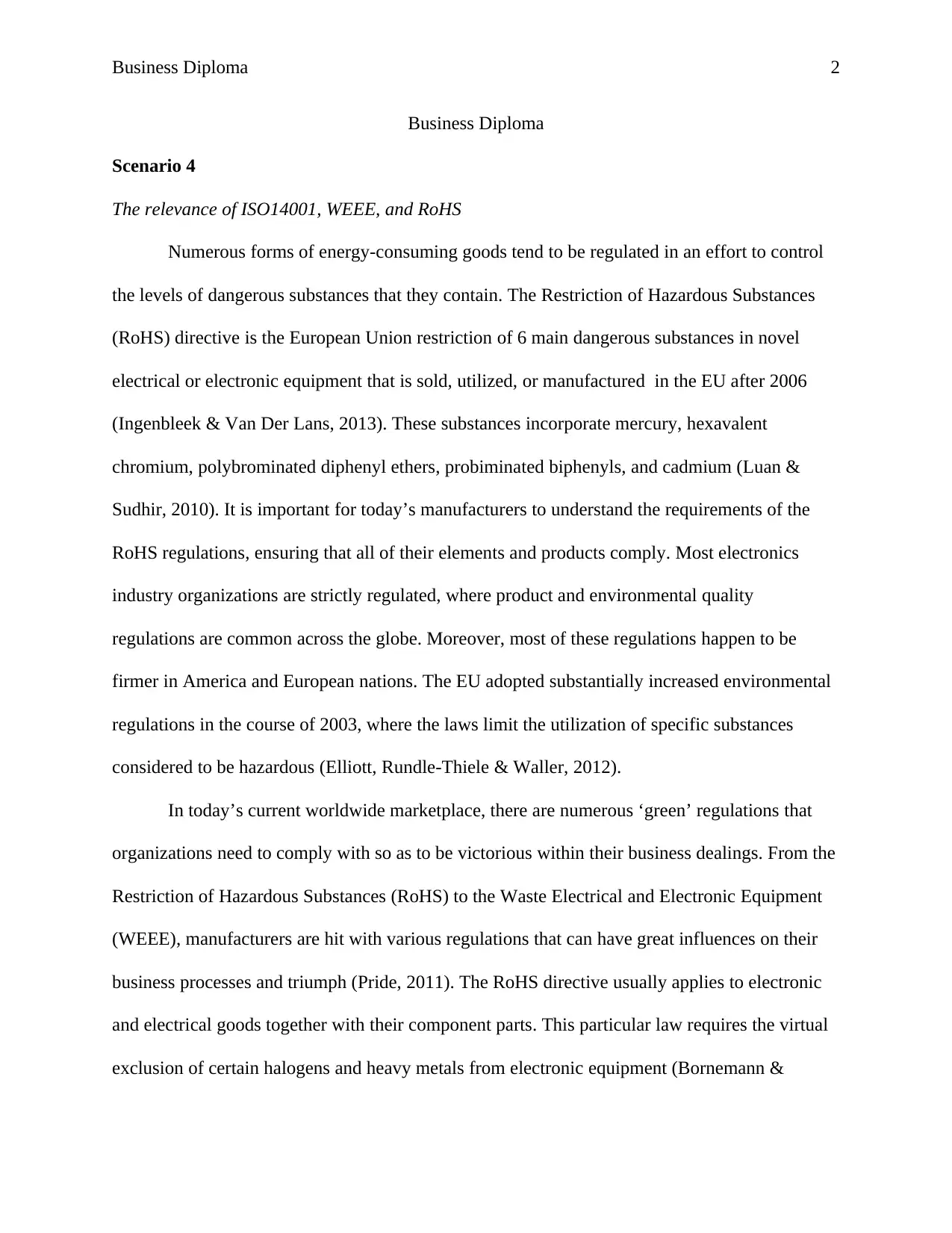
Business Diploma 2
Business Diploma
Scenario 4
The relevance of ISO14001, WEEE, and RoHS
Numerous forms of energy-consuming goods tend to be regulated in an effort to control
the levels of dangerous substances that they contain. The Restriction of Hazardous Substances
(RoHS) directive is the European Union restriction of 6 main dangerous substances in novel
electrical or electronic equipment that is sold, utilized, or manufactured in the EU after 2006
(Ingenbleek & Van Der Lans, 2013). These substances incorporate mercury, hexavalent
chromium, polybrominated diphenyl ethers, probiminated biphenyls, and cadmium (Luan &
Sudhir, 2010). It is important for today’s manufacturers to understand the requirements of the
RoHS regulations, ensuring that all of their elements and products comply. Most electronics
industry organizations are strictly regulated, where product and environmental quality
regulations are common across the globe. Moreover, most of these regulations happen to be
firmer in America and European nations. The EU adopted substantially increased environmental
regulations in the course of 2003, where the laws limit the utilization of specific substances
considered to be hazardous (Elliott, Rundle-Thiele & Waller, 2012).
In today’s current worldwide marketplace, there are numerous ‘green’ regulations that
organizations need to comply with so as to be victorious within their business dealings. From the
Restriction of Hazardous Substances (RoHS) to the Waste Electrical and Electronic Equipment
(WEEE), manufacturers are hit with various regulations that can have great influences on their
business processes and triumph (Pride, 2011). The RoHS directive usually applies to electronic
and electrical goods together with their component parts. This particular law requires the virtual
exclusion of certain halogens and heavy metals from electronic equipment (Bornemann &
Business Diploma
Scenario 4
The relevance of ISO14001, WEEE, and RoHS
Numerous forms of energy-consuming goods tend to be regulated in an effort to control
the levels of dangerous substances that they contain. The Restriction of Hazardous Substances
(RoHS) directive is the European Union restriction of 6 main dangerous substances in novel
electrical or electronic equipment that is sold, utilized, or manufactured in the EU after 2006
(Ingenbleek & Van Der Lans, 2013). These substances incorporate mercury, hexavalent
chromium, polybrominated diphenyl ethers, probiminated biphenyls, and cadmium (Luan &
Sudhir, 2010). It is important for today’s manufacturers to understand the requirements of the
RoHS regulations, ensuring that all of their elements and products comply. Most electronics
industry organizations are strictly regulated, where product and environmental quality
regulations are common across the globe. Moreover, most of these regulations happen to be
firmer in America and European nations. The EU adopted substantially increased environmental
regulations in the course of 2003, where the laws limit the utilization of specific substances
considered to be hazardous (Elliott, Rundle-Thiele & Waller, 2012).
In today’s current worldwide marketplace, there are numerous ‘green’ regulations that
organizations need to comply with so as to be victorious within their business dealings. From the
Restriction of Hazardous Substances (RoHS) to the Waste Electrical and Electronic Equipment
(WEEE), manufacturers are hit with various regulations that can have great influences on their
business processes and triumph (Pride, 2011). The RoHS directive usually applies to electronic
and electrical goods together with their component parts. This particular law requires the virtual
exclusion of certain halogens and heavy metals from electronic equipment (Bornemann &
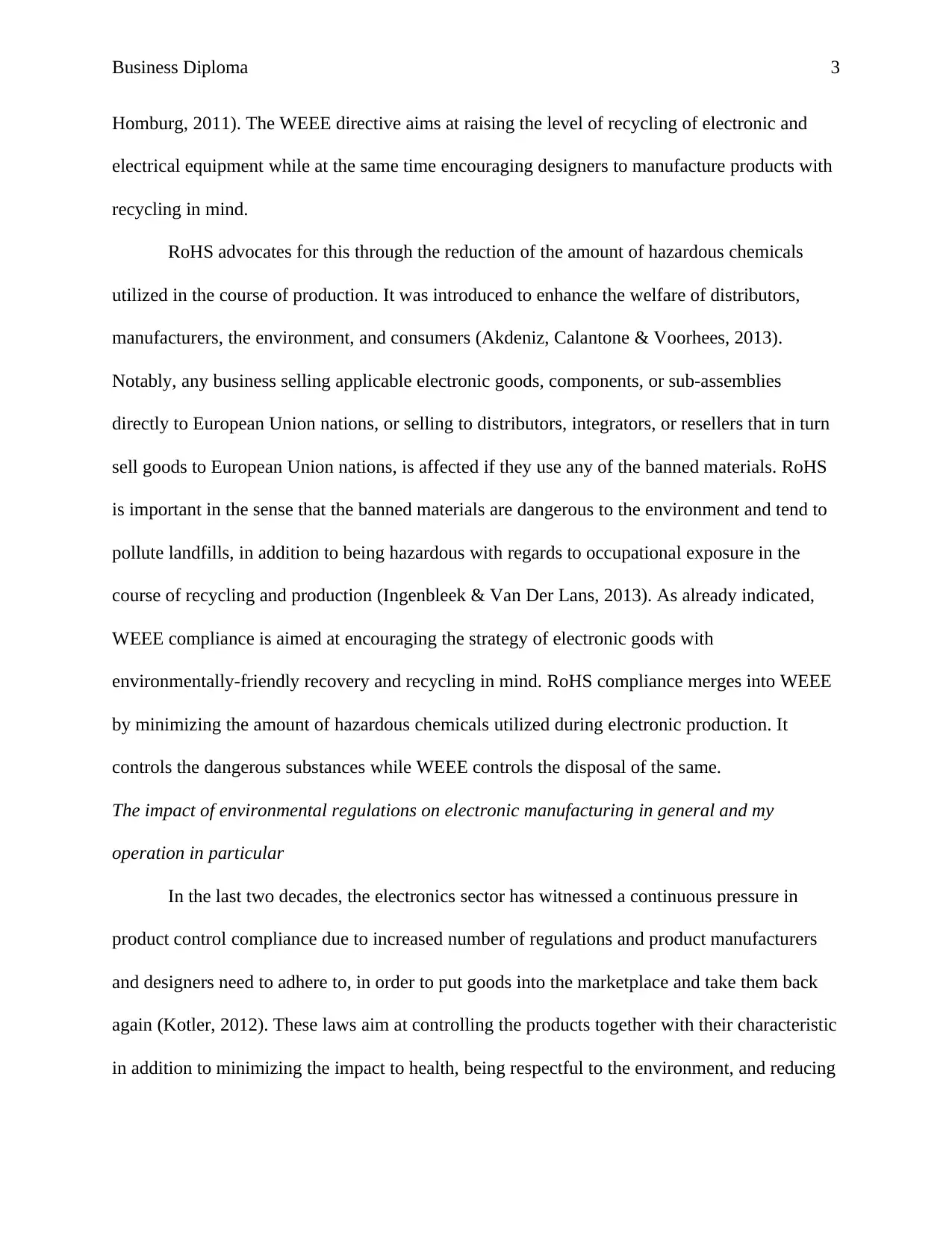
Business Diploma 3
Homburg, 2011). The WEEE directive aims at raising the level of recycling of electronic and
electrical equipment while at the same time encouraging designers to manufacture products with
recycling in mind.
RoHS advocates for this through the reduction of the amount of hazardous chemicals
utilized in the course of production. It was introduced to enhance the welfare of distributors,
manufacturers, the environment, and consumers (Akdeniz, Calantone & Voorhees, 2013).
Notably, any business selling applicable electronic goods, components, or sub-assemblies
directly to European Union nations, or selling to distributors, integrators, or resellers that in turn
sell goods to European Union nations, is affected if they use any of the banned materials. RoHS
is important in the sense that the banned materials are dangerous to the environment and tend to
pollute landfills, in addition to being hazardous with regards to occupational exposure in the
course of recycling and production (Ingenbleek & Van Der Lans, 2013). As already indicated,
WEEE compliance is aimed at encouraging the strategy of electronic goods with
environmentally-friendly recovery and recycling in mind. RoHS compliance merges into WEEE
by minimizing the amount of hazardous chemicals utilized during electronic production. It
controls the dangerous substances while WEEE controls the disposal of the same.
The impact of environmental regulations on electronic manufacturing in general and my
operation in particular
In the last two decades, the electronics sector has witnessed a continuous pressure in
product control compliance due to increased number of regulations and product manufacturers
and designers need to adhere to, in order to put goods into the marketplace and take them back
again (Kotler, 2012). These laws aim at controlling the products together with their characteristic
in addition to minimizing the impact to health, being respectful to the environment, and reducing
Homburg, 2011). The WEEE directive aims at raising the level of recycling of electronic and
electrical equipment while at the same time encouraging designers to manufacture products with
recycling in mind.
RoHS advocates for this through the reduction of the amount of hazardous chemicals
utilized in the course of production. It was introduced to enhance the welfare of distributors,
manufacturers, the environment, and consumers (Akdeniz, Calantone & Voorhees, 2013).
Notably, any business selling applicable electronic goods, components, or sub-assemblies
directly to European Union nations, or selling to distributors, integrators, or resellers that in turn
sell goods to European Union nations, is affected if they use any of the banned materials. RoHS
is important in the sense that the banned materials are dangerous to the environment and tend to
pollute landfills, in addition to being hazardous with regards to occupational exposure in the
course of recycling and production (Ingenbleek & Van Der Lans, 2013). As already indicated,
WEEE compliance is aimed at encouraging the strategy of electronic goods with
environmentally-friendly recovery and recycling in mind. RoHS compliance merges into WEEE
by minimizing the amount of hazardous chemicals utilized during electronic production. It
controls the dangerous substances while WEEE controls the disposal of the same.
The impact of environmental regulations on electronic manufacturing in general and my
operation in particular
In the last two decades, the electronics sector has witnessed a continuous pressure in
product control compliance due to increased number of regulations and product manufacturers
and designers need to adhere to, in order to put goods into the marketplace and take them back
again (Kotler, 2012). These laws aim at controlling the products together with their characteristic
in addition to minimizing the impact to health, being respectful to the environment, and reducing
⊘ This is a preview!⊘
Do you want full access?
Subscribe today to unlock all pages.

Trusted by 1+ million students worldwide
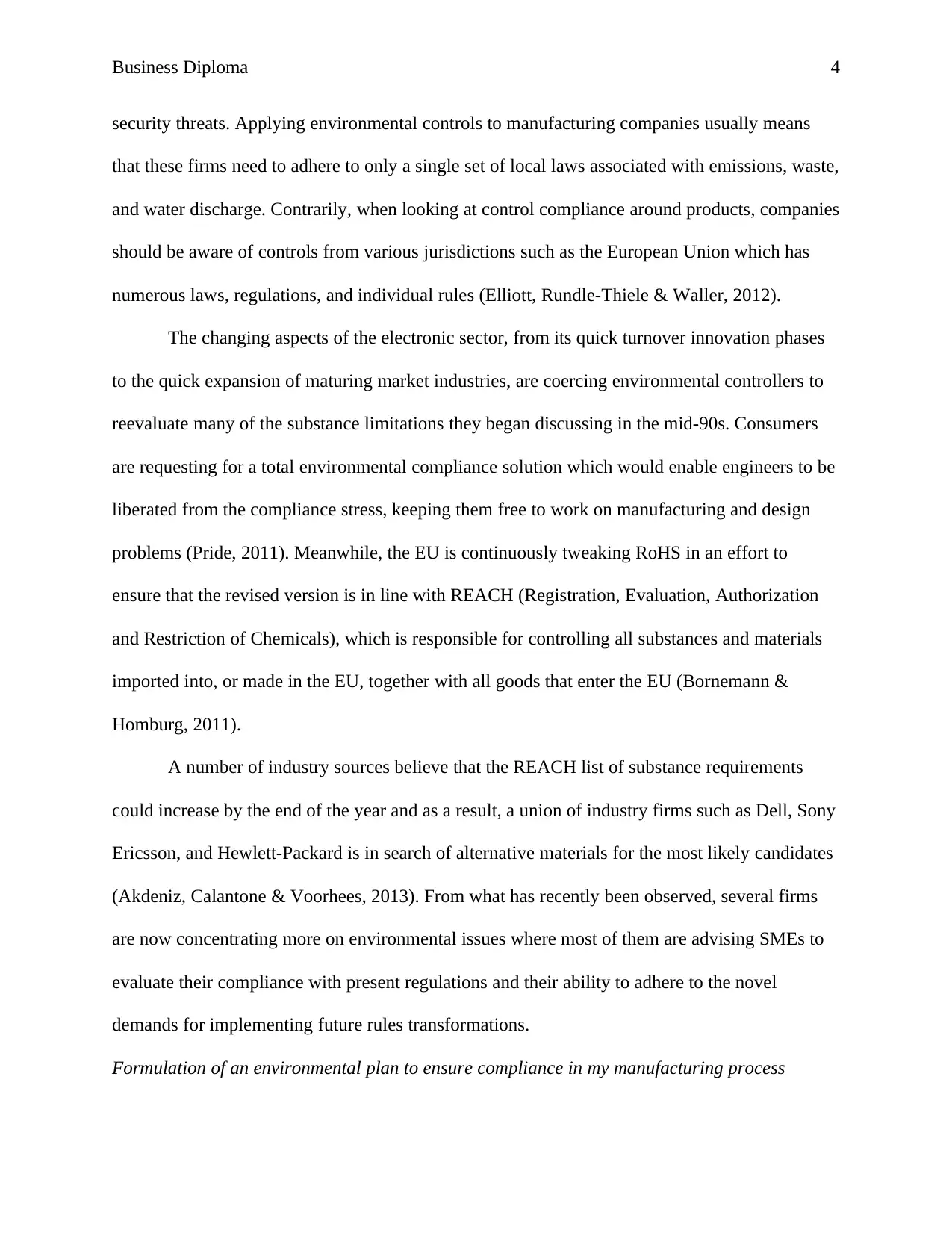
Business Diploma 4
security threats. Applying environmental controls to manufacturing companies usually means
that these firms need to adhere to only a single set of local laws associated with emissions, waste,
and water discharge. Contrarily, when looking at control compliance around products, companies
should be aware of controls from various jurisdictions such as the European Union which has
numerous laws, regulations, and individual rules (Elliott, Rundle-Thiele & Waller, 2012).
The changing aspects of the electronic sector, from its quick turnover innovation phases
to the quick expansion of maturing market industries, are coercing environmental controllers to
reevaluate many of the substance limitations they began discussing in the mid-90s. Consumers
are requesting for a total environmental compliance solution which would enable engineers to be
liberated from the compliance stress, keeping them free to work on manufacturing and design
problems (Pride, 2011). Meanwhile, the EU is continuously tweaking RoHS in an effort to
ensure that the revised version is in line with REACH (Registration, Evaluation, Authorization
and Restriction of Chemicals), which is responsible for controlling all substances and materials
imported into, or made in the EU, together with all goods that enter the EU (Bornemann &
Homburg, 2011).
A number of industry sources believe that the REACH list of substance requirements
could increase by the end of the year and as a result, a union of industry firms such as Dell, Sony
Ericsson, and Hewlett-Packard is in search of alternative materials for the most likely candidates
(Akdeniz, Calantone & Voorhees, 2013). From what has recently been observed, several firms
are now concentrating more on environmental issues where most of them are advising SMEs to
evaluate their compliance with present regulations and their ability to adhere to the novel
demands for implementing future rules transformations.
Formulation of an environmental plan to ensure compliance in my manufacturing process
security threats. Applying environmental controls to manufacturing companies usually means
that these firms need to adhere to only a single set of local laws associated with emissions, waste,
and water discharge. Contrarily, when looking at control compliance around products, companies
should be aware of controls from various jurisdictions such as the European Union which has
numerous laws, regulations, and individual rules (Elliott, Rundle-Thiele & Waller, 2012).
The changing aspects of the electronic sector, from its quick turnover innovation phases
to the quick expansion of maturing market industries, are coercing environmental controllers to
reevaluate many of the substance limitations they began discussing in the mid-90s. Consumers
are requesting for a total environmental compliance solution which would enable engineers to be
liberated from the compliance stress, keeping them free to work on manufacturing and design
problems (Pride, 2011). Meanwhile, the EU is continuously tweaking RoHS in an effort to
ensure that the revised version is in line with REACH (Registration, Evaluation, Authorization
and Restriction of Chemicals), which is responsible for controlling all substances and materials
imported into, or made in the EU, together with all goods that enter the EU (Bornemann &
Homburg, 2011).
A number of industry sources believe that the REACH list of substance requirements
could increase by the end of the year and as a result, a union of industry firms such as Dell, Sony
Ericsson, and Hewlett-Packard is in search of alternative materials for the most likely candidates
(Akdeniz, Calantone & Voorhees, 2013). From what has recently been observed, several firms
are now concentrating more on environmental issues where most of them are advising SMEs to
evaluate their compliance with present regulations and their ability to adhere to the novel
demands for implementing future rules transformations.
Formulation of an environmental plan to ensure compliance in my manufacturing process
Paraphrase This Document
Need a fresh take? Get an instant paraphrase of this document with our AI Paraphraser
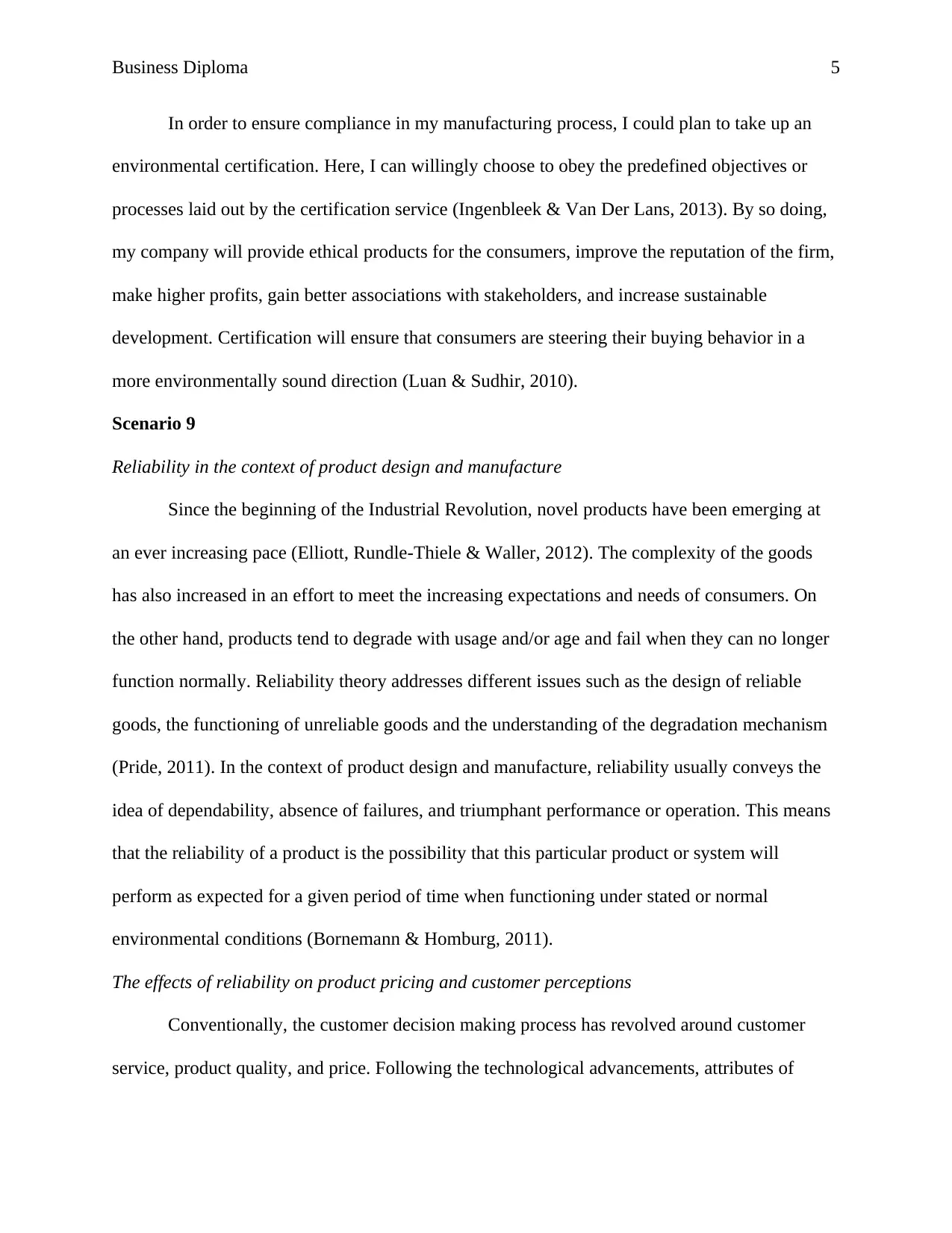
Business Diploma 5
In order to ensure compliance in my manufacturing process, I could plan to take up an
environmental certification. Here, I can willingly choose to obey the predefined objectives or
processes laid out by the certification service (Ingenbleek & Van Der Lans, 2013). By so doing,
my company will provide ethical products for the consumers, improve the reputation of the firm,
make higher profits, gain better associations with stakeholders, and increase sustainable
development. Certification will ensure that consumers are steering their buying behavior in a
more environmentally sound direction (Luan & Sudhir, 2010).
Scenario 9
Reliability in the context of product design and manufacture
Since the beginning of the Industrial Revolution, novel products have been emerging at
an ever increasing pace (Elliott, Rundle-Thiele & Waller, 2012). The complexity of the goods
has also increased in an effort to meet the increasing expectations and needs of consumers. On
the other hand, products tend to degrade with usage and/or age and fail when they can no longer
function normally. Reliability theory addresses different issues such as the design of reliable
goods, the functioning of unreliable goods and the understanding of the degradation mechanism
(Pride, 2011). In the context of product design and manufacture, reliability usually conveys the
idea of dependability, absence of failures, and triumphant performance or operation. This means
that the reliability of a product is the possibility that this particular product or system will
perform as expected for a given period of time when functioning under stated or normal
environmental conditions (Bornemann & Homburg, 2011).
The effects of reliability on product pricing and customer perceptions
Conventionally, the customer decision making process has revolved around customer
service, product quality, and price. Following the technological advancements, attributes of
In order to ensure compliance in my manufacturing process, I could plan to take up an
environmental certification. Here, I can willingly choose to obey the predefined objectives or
processes laid out by the certification service (Ingenbleek & Van Der Lans, 2013). By so doing,
my company will provide ethical products for the consumers, improve the reputation of the firm,
make higher profits, gain better associations with stakeholders, and increase sustainable
development. Certification will ensure that consumers are steering their buying behavior in a
more environmentally sound direction (Luan & Sudhir, 2010).
Scenario 9
Reliability in the context of product design and manufacture
Since the beginning of the Industrial Revolution, novel products have been emerging at
an ever increasing pace (Elliott, Rundle-Thiele & Waller, 2012). The complexity of the goods
has also increased in an effort to meet the increasing expectations and needs of consumers. On
the other hand, products tend to degrade with usage and/or age and fail when they can no longer
function normally. Reliability theory addresses different issues such as the design of reliable
goods, the functioning of unreliable goods and the understanding of the degradation mechanism
(Pride, 2011). In the context of product design and manufacture, reliability usually conveys the
idea of dependability, absence of failures, and triumphant performance or operation. This means
that the reliability of a product is the possibility that this particular product or system will
perform as expected for a given period of time when functioning under stated or normal
environmental conditions (Bornemann & Homburg, 2011).
The effects of reliability on product pricing and customer perceptions
Conventionally, the customer decision making process has revolved around customer
service, product quality, and price. Following the technological advancements, attributes of
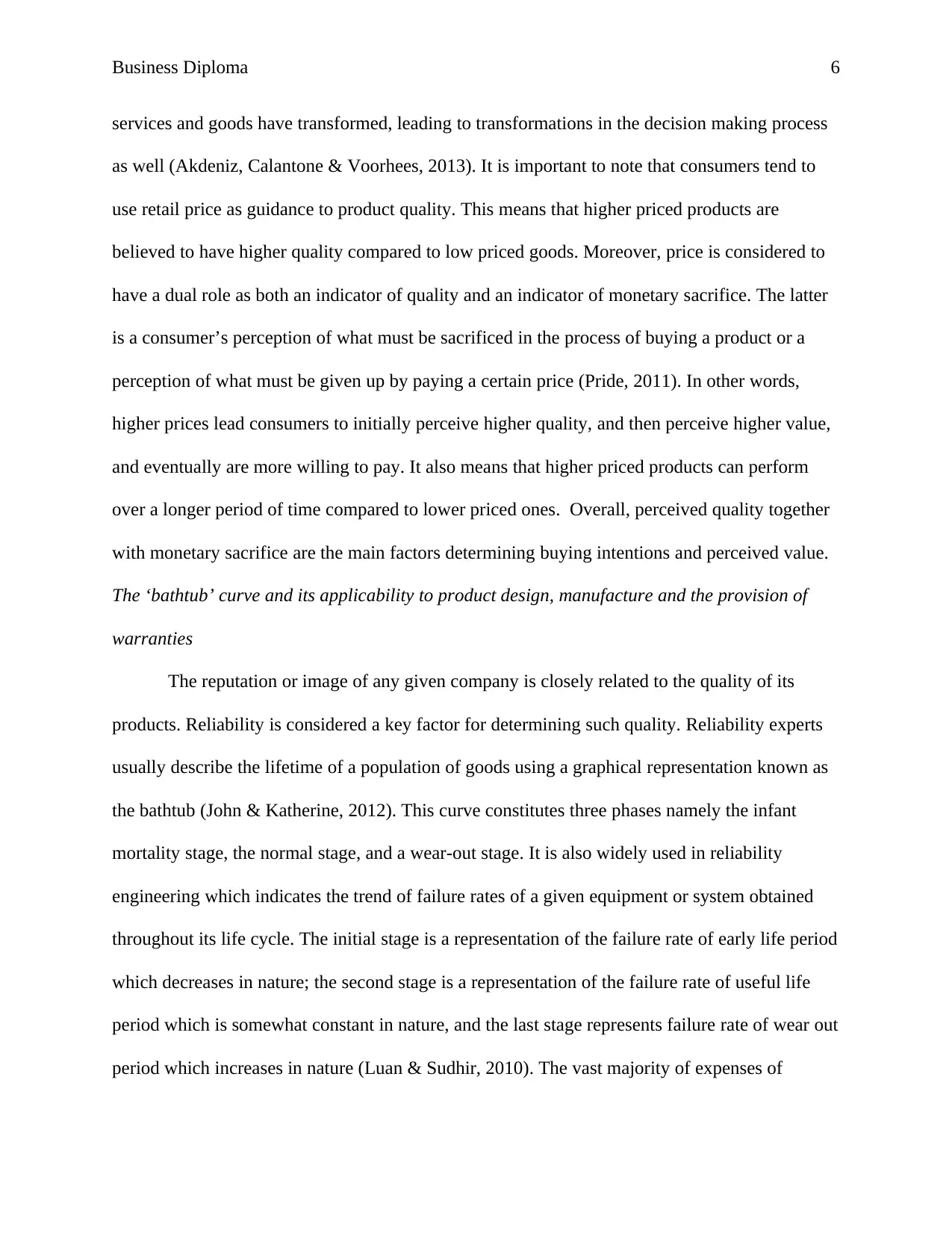
Business Diploma 6
services and goods have transformed, leading to transformations in the decision making process
as well (Akdeniz, Calantone & Voorhees, 2013). It is important to note that consumers tend to
use retail price as guidance to product quality. This means that higher priced products are
believed to have higher quality compared to low priced goods. Moreover, price is considered to
have a dual role as both an indicator of quality and an indicator of monetary sacrifice. The latter
is a consumer’s perception of what must be sacrificed in the process of buying a product or a
perception of what must be given up by paying a certain price (Pride, 2011). In other words,
higher prices lead consumers to initially perceive higher quality, and then perceive higher value,
and eventually are more willing to pay. It also means that higher priced products can perform
over a longer period of time compared to lower priced ones. Overall, perceived quality together
with monetary sacrifice are the main factors determining buying intentions and perceived value.
The ‘bathtub’ curve and its applicability to product design, manufacture and the provision of
warranties
The reputation or image of any given company is closely related to the quality of its
products. Reliability is considered a key factor for determining such quality. Reliability experts
usually describe the lifetime of a population of goods using a graphical representation known as
the bathtub (John & Katherine, 2012). This curve constitutes three phases namely the infant
mortality stage, the normal stage, and a wear-out stage. It is also widely used in reliability
engineering which indicates the trend of failure rates of a given equipment or system obtained
throughout its life cycle. The initial stage is a representation of the failure rate of early life period
which decreases in nature; the second stage is a representation of the failure rate of useful life
period which is somewhat constant in nature, and the last stage represents failure rate of wear out
period which increases in nature (Luan & Sudhir, 2010). The vast majority of expenses of
services and goods have transformed, leading to transformations in the decision making process
as well (Akdeniz, Calantone & Voorhees, 2013). It is important to note that consumers tend to
use retail price as guidance to product quality. This means that higher priced products are
believed to have higher quality compared to low priced goods. Moreover, price is considered to
have a dual role as both an indicator of quality and an indicator of monetary sacrifice. The latter
is a consumer’s perception of what must be sacrificed in the process of buying a product or a
perception of what must be given up by paying a certain price (Pride, 2011). In other words,
higher prices lead consumers to initially perceive higher quality, and then perceive higher value,
and eventually are more willing to pay. It also means that higher priced products can perform
over a longer period of time compared to lower priced ones. Overall, perceived quality together
with monetary sacrifice are the main factors determining buying intentions and perceived value.
The ‘bathtub’ curve and its applicability to product design, manufacture and the provision of
warranties
The reputation or image of any given company is closely related to the quality of its
products. Reliability is considered a key factor for determining such quality. Reliability experts
usually describe the lifetime of a population of goods using a graphical representation known as
the bathtub (John & Katherine, 2012). This curve constitutes three phases namely the infant
mortality stage, the normal stage, and a wear-out stage. It is also widely used in reliability
engineering which indicates the trend of failure rates of a given equipment or system obtained
throughout its life cycle. The initial stage is a representation of the failure rate of early life period
which decreases in nature; the second stage is a representation of the failure rate of useful life
period which is somewhat constant in nature, and the last stage represents failure rate of wear out
period which increases in nature (Luan & Sudhir, 2010). The vast majority of expenses of
⊘ This is a preview!⊘
Do you want full access?
Subscribe today to unlock all pages.

Trusted by 1+ million students worldwide
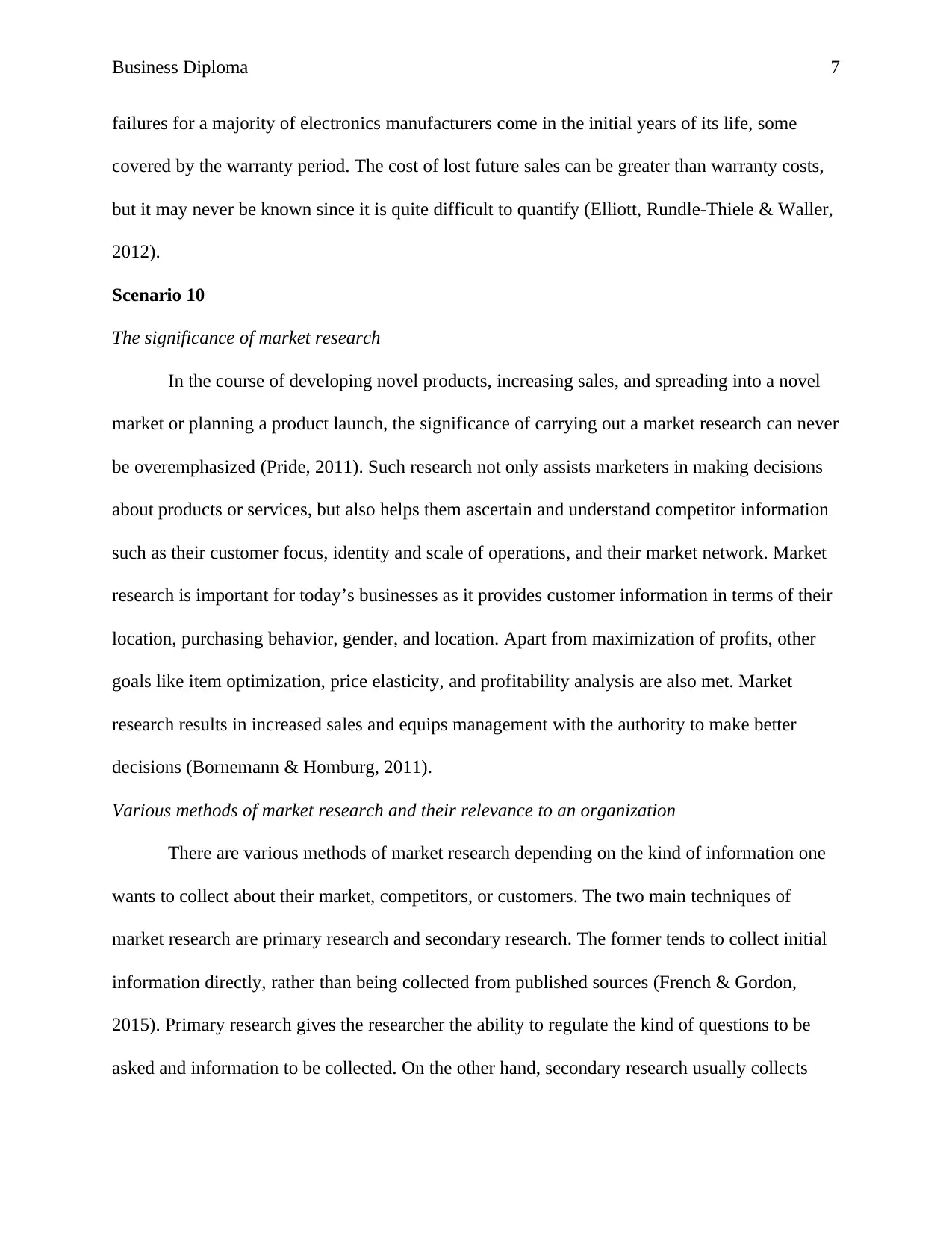
Business Diploma 7
failures for a majority of electronics manufacturers come in the initial years of its life, some
covered by the warranty period. The cost of lost future sales can be greater than warranty costs,
but it may never be known since it is quite difficult to quantify (Elliott, Rundle-Thiele & Waller,
2012).
Scenario 10
The significance of market research
In the course of developing novel products, increasing sales, and spreading into a novel
market or planning a product launch, the significance of carrying out a market research can never
be overemphasized (Pride, 2011). Such research not only assists marketers in making decisions
about products or services, but also helps them ascertain and understand competitor information
such as their customer focus, identity and scale of operations, and their market network. Market
research is important for today’s businesses as it provides customer information in terms of their
location, purchasing behavior, gender, and location. Apart from maximization of profits, other
goals like item optimization, price elasticity, and profitability analysis are also met. Market
research results in increased sales and equips management with the authority to make better
decisions (Bornemann & Homburg, 2011).
Various methods of market research and their relevance to an organization
There are various methods of market research depending on the kind of information one
wants to collect about their market, competitors, or customers. The two main techniques of
market research are primary research and secondary research. The former tends to collect initial
information directly, rather than being collected from published sources (French & Gordon,
2015). Primary research gives the researcher the ability to regulate the kind of questions to be
asked and information to be collected. On the other hand, secondary research usually collects
failures for a majority of electronics manufacturers come in the initial years of its life, some
covered by the warranty period. The cost of lost future sales can be greater than warranty costs,
but it may never be known since it is quite difficult to quantify (Elliott, Rundle-Thiele & Waller,
2012).
Scenario 10
The significance of market research
In the course of developing novel products, increasing sales, and spreading into a novel
market or planning a product launch, the significance of carrying out a market research can never
be overemphasized (Pride, 2011). Such research not only assists marketers in making decisions
about products or services, but also helps them ascertain and understand competitor information
such as their customer focus, identity and scale of operations, and their market network. Market
research is important for today’s businesses as it provides customer information in terms of their
location, purchasing behavior, gender, and location. Apart from maximization of profits, other
goals like item optimization, price elasticity, and profitability analysis are also met. Market
research results in increased sales and equips management with the authority to make better
decisions (Bornemann & Homburg, 2011).
Various methods of market research and their relevance to an organization
There are various methods of market research depending on the kind of information one
wants to collect about their market, competitors, or customers. The two main techniques of
market research are primary research and secondary research. The former tends to collect initial
information directly, rather than being collected from published sources (French & Gordon,
2015). Primary research gives the researcher the ability to regulate the kind of questions to be
asked and information to be collected. On the other hand, secondary research usually collects
Paraphrase This Document
Need a fresh take? Get an instant paraphrase of this document with our AI Paraphraser
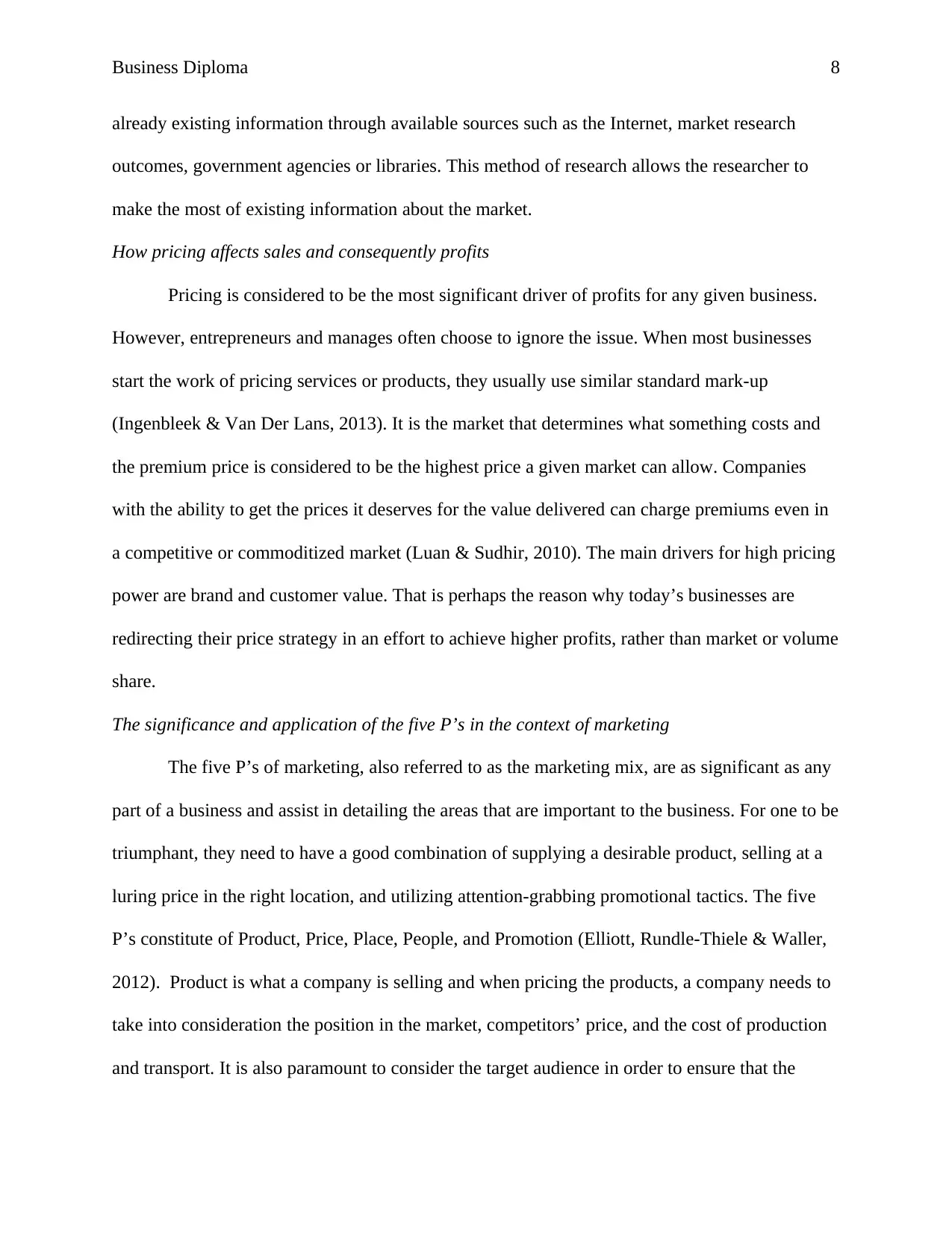
Business Diploma 8
already existing information through available sources such as the Internet, market research
outcomes, government agencies or libraries. This method of research allows the researcher to
make the most of existing information about the market.
How pricing affects sales and consequently profits
Pricing is considered to be the most significant driver of profits for any given business.
However, entrepreneurs and manages often choose to ignore the issue. When most businesses
start the work of pricing services or products, they usually use similar standard mark-up
(Ingenbleek & Van Der Lans, 2013). It is the market that determines what something costs and
the premium price is considered to be the highest price a given market can allow. Companies
with the ability to get the prices it deserves for the value delivered can charge premiums even in
a competitive or commoditized market (Luan & Sudhir, 2010). The main drivers for high pricing
power are brand and customer value. That is perhaps the reason why today’s businesses are
redirecting their price strategy in an effort to achieve higher profits, rather than market or volume
share.
The significance and application of the five P’s in the context of marketing
The five P’s of marketing, also referred to as the marketing mix, are as significant as any
part of a business and assist in detailing the areas that are important to the business. For one to be
triumphant, they need to have a good combination of supplying a desirable product, selling at a
luring price in the right location, and utilizing attention-grabbing promotional tactics. The five
P’s constitute of Product, Price, Place, People, and Promotion (Elliott, Rundle-Thiele & Waller,
2012). Product is what a company is selling and when pricing the products, a company needs to
take into consideration the position in the market, competitors’ price, and the cost of production
and transport. It is also paramount to consider the target audience in order to ensure that the
already existing information through available sources such as the Internet, market research
outcomes, government agencies or libraries. This method of research allows the researcher to
make the most of existing information about the market.
How pricing affects sales and consequently profits
Pricing is considered to be the most significant driver of profits for any given business.
However, entrepreneurs and manages often choose to ignore the issue. When most businesses
start the work of pricing services or products, they usually use similar standard mark-up
(Ingenbleek & Van Der Lans, 2013). It is the market that determines what something costs and
the premium price is considered to be the highest price a given market can allow. Companies
with the ability to get the prices it deserves for the value delivered can charge premiums even in
a competitive or commoditized market (Luan & Sudhir, 2010). The main drivers for high pricing
power are brand and customer value. That is perhaps the reason why today’s businesses are
redirecting their price strategy in an effort to achieve higher profits, rather than market or volume
share.
The significance and application of the five P’s in the context of marketing
The five P’s of marketing, also referred to as the marketing mix, are as significant as any
part of a business and assist in detailing the areas that are important to the business. For one to be
triumphant, they need to have a good combination of supplying a desirable product, selling at a
luring price in the right location, and utilizing attention-grabbing promotional tactics. The five
P’s constitute of Product, Price, Place, People, and Promotion (Elliott, Rundle-Thiele & Waller,
2012). Product is what a company is selling and when pricing the products, a company needs to
take into consideration the position in the market, competitors’ price, and the cost of production
and transport. It is also paramount to consider the target audience in order to ensure that the
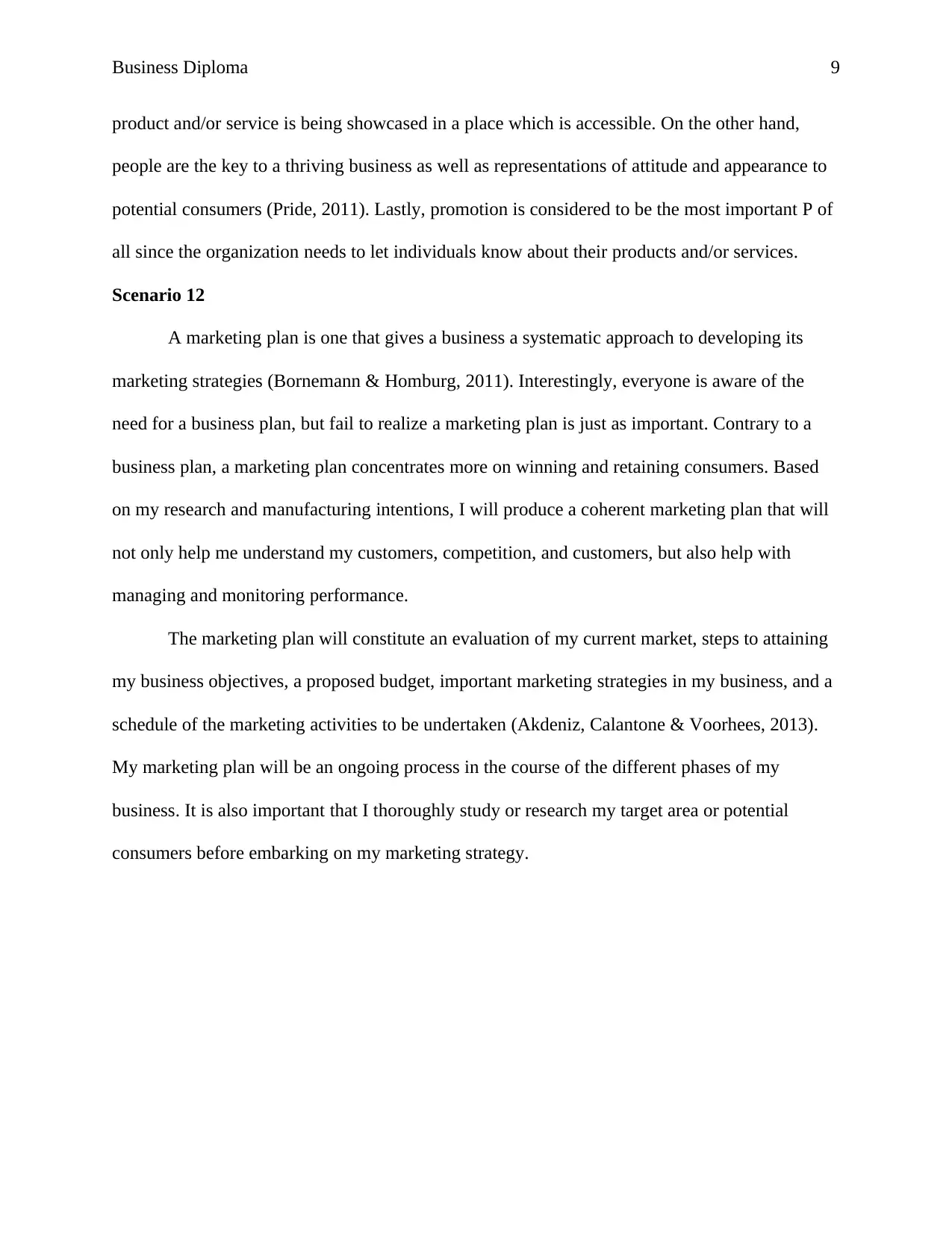
Business Diploma 9
product and/or service is being showcased in a place which is accessible. On the other hand,
people are the key to a thriving business as well as representations of attitude and appearance to
potential consumers (Pride, 2011). Lastly, promotion is considered to be the most important P of
all since the organization needs to let individuals know about their products and/or services.
Scenario 12
A marketing plan is one that gives a business a systematic approach to developing its
marketing strategies (Bornemann & Homburg, 2011). Interestingly, everyone is aware of the
need for a business plan, but fail to realize a marketing plan is just as important. Contrary to a
business plan, a marketing plan concentrates more on winning and retaining consumers. Based
on my research and manufacturing intentions, I will produce a coherent marketing plan that will
not only help me understand my customers, competition, and customers, but also help with
managing and monitoring performance.
The marketing plan will constitute an evaluation of my current market, steps to attaining
my business objectives, a proposed budget, important marketing strategies in my business, and a
schedule of the marketing activities to be undertaken (Akdeniz, Calantone & Voorhees, 2013).
My marketing plan will be an ongoing process in the course of the different phases of my
business. It is also important that I thoroughly study or research my target area or potential
consumers before embarking on my marketing strategy.
product and/or service is being showcased in a place which is accessible. On the other hand,
people are the key to a thriving business as well as representations of attitude and appearance to
potential consumers (Pride, 2011). Lastly, promotion is considered to be the most important P of
all since the organization needs to let individuals know about their products and/or services.
Scenario 12
A marketing plan is one that gives a business a systematic approach to developing its
marketing strategies (Bornemann & Homburg, 2011). Interestingly, everyone is aware of the
need for a business plan, but fail to realize a marketing plan is just as important. Contrary to a
business plan, a marketing plan concentrates more on winning and retaining consumers. Based
on my research and manufacturing intentions, I will produce a coherent marketing plan that will
not only help me understand my customers, competition, and customers, but also help with
managing and monitoring performance.
The marketing plan will constitute an evaluation of my current market, steps to attaining
my business objectives, a proposed budget, important marketing strategies in my business, and a
schedule of the marketing activities to be undertaken (Akdeniz, Calantone & Voorhees, 2013).
My marketing plan will be an ongoing process in the course of the different phases of my
business. It is also important that I thoroughly study or research my target area or potential
consumers before embarking on my marketing strategy.
⊘ This is a preview!⊘
Do you want full access?
Subscribe today to unlock all pages.

Trusted by 1+ million students worldwide
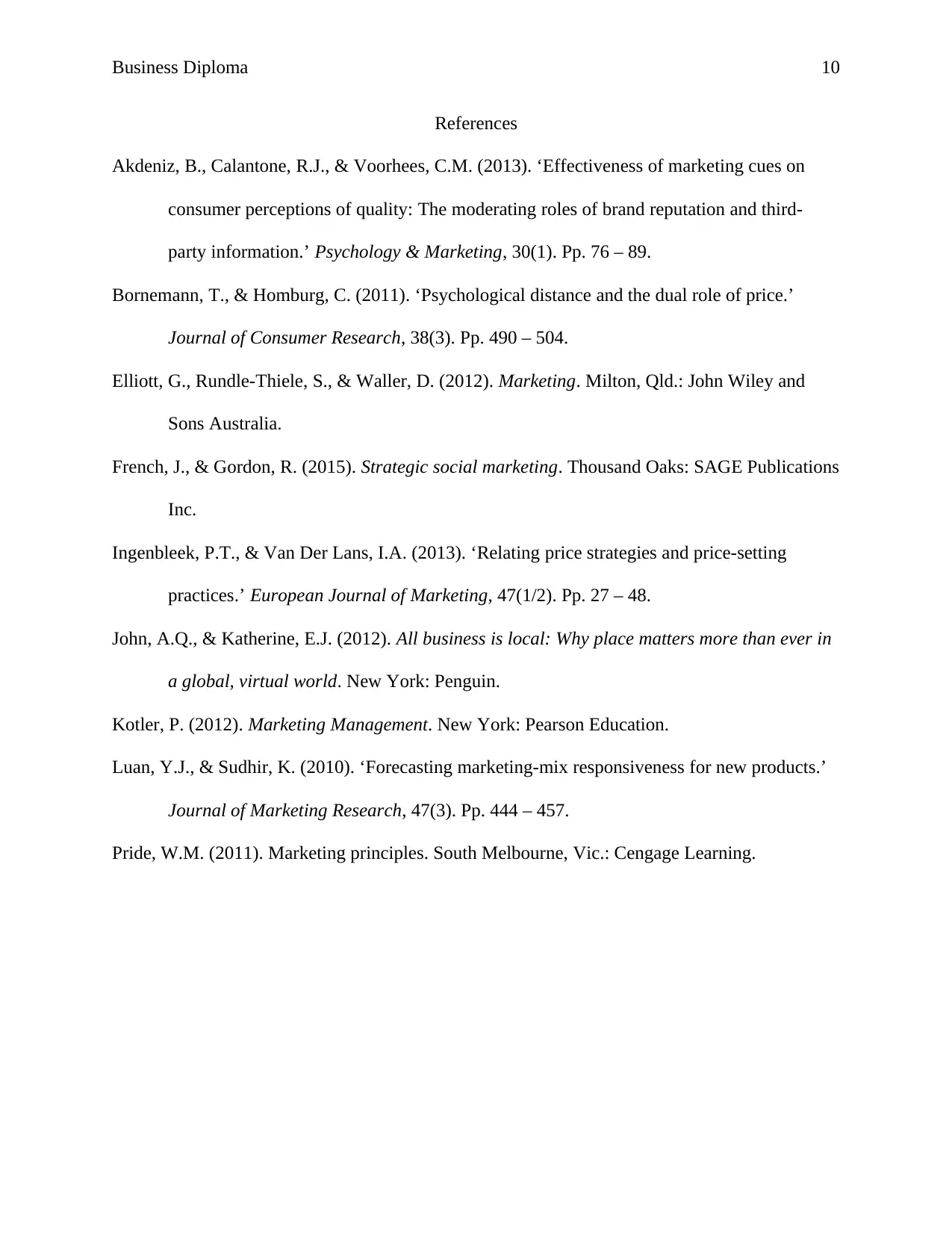
Business Diploma 10
References
Akdeniz, B., Calantone, R.J., & Voorhees, C.M. (2013). ‘Effectiveness of marketing cues on
consumer perceptions of quality: The moderating roles of brand reputation and third-
party information.’ Psychology & Marketing, 30(1). Pp. 76 – 89.
Bornemann, T., & Homburg, C. (2011). ‘Psychological distance and the dual role of price.’
Journal of Consumer Research, 38(3). Pp. 490 – 504.
Elliott, G., Rundle-Thiele, S., & Waller, D. (2012). Marketing. Milton, Qld.: John Wiley and
Sons Australia.
French, J., & Gordon, R. (2015). Strategic social marketing. Thousand Oaks: SAGE Publications
Inc.
Ingenbleek, P.T., & Van Der Lans, I.A. (2013). ‘Relating price strategies and price-setting
practices.’ European Journal of Marketing, 47(1/2). Pp. 27 – 48.
John, A.Q., & Katherine, E.J. (2012). All business is local: Why place matters more than ever in
a global, virtual world. New York: Penguin.
Kotler, P. (2012). Marketing Management. New York: Pearson Education.
Luan, Y.J., & Sudhir, K. (2010). ‘Forecasting marketing-mix responsiveness for new products.’
Journal of Marketing Research, 47(3). Pp. 444 – 457.
Pride, W.M. (2011). Marketing principles. South Melbourne, Vic.: Cengage Learning.
References
Akdeniz, B., Calantone, R.J., & Voorhees, C.M. (2013). ‘Effectiveness of marketing cues on
consumer perceptions of quality: The moderating roles of brand reputation and third-
party information.’ Psychology & Marketing, 30(1). Pp. 76 – 89.
Bornemann, T., & Homburg, C. (2011). ‘Psychological distance and the dual role of price.’
Journal of Consumer Research, 38(3). Pp. 490 – 504.
Elliott, G., Rundle-Thiele, S., & Waller, D. (2012). Marketing. Milton, Qld.: John Wiley and
Sons Australia.
French, J., & Gordon, R. (2015). Strategic social marketing. Thousand Oaks: SAGE Publications
Inc.
Ingenbleek, P.T., & Van Der Lans, I.A. (2013). ‘Relating price strategies and price-setting
practices.’ European Journal of Marketing, 47(1/2). Pp. 27 – 48.
John, A.Q., & Katherine, E.J. (2012). All business is local: Why place matters more than ever in
a global, virtual world. New York: Penguin.
Kotler, P. (2012). Marketing Management. New York: Pearson Education.
Luan, Y.J., & Sudhir, K. (2010). ‘Forecasting marketing-mix responsiveness for new products.’
Journal of Marketing Research, 47(3). Pp. 444 – 457.
Pride, W.M. (2011). Marketing principles. South Melbourne, Vic.: Cengage Learning.
1 out of 10
Your All-in-One AI-Powered Toolkit for Academic Success.
+13062052269
info@desklib.com
Available 24*7 on WhatsApp / Email
![[object Object]](/_next/static/media/star-bottom.7253800d.svg)
Unlock your academic potential
Copyright © 2020–2025 A2Z Services. All Rights Reserved. Developed and managed by ZUCOL.
